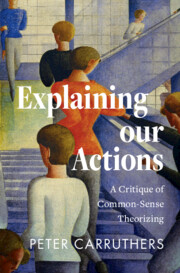Refine search
Actions for selected content:
194 results
Chapter 22 - Neural Mechanisms of Arbitration between Multiple Experts in Value-Based Decision-Making
- from Section V - Cognition–Emotion Interactions
-
-
- Book:
- The Cambridge Handbook of Human Affective Neuroscience
- Published online:
- 16 September 2025
- Print publication:
- 02 October 2025, pp 444-463
-
- Chapter
- Export citation
8 - The Allegory of the Diamond
- from Part IV - Pathways Forward
-
- Book:
- AI versus IP
- Published online:
- 09 August 2025
- Print publication:
- 28 August 2025, pp 113-114
-
- Chapter
- Export citation
Chapter 7 - Plato
-
- Book:
- Aggregation and Antithesis in Ancient Greece
- Published online:
- 21 October 2025
- Print publication:
- 28 August 2025, pp 173-190
-
- Chapter
- Export citation
Chapter 7 - The Economy in the Feyerabend Lecture Notes on Natural Right
-
-
- Book:
- Kant's Lectures on Political Philosophy
- Published online:
- 18 July 2025
- Print publication:
- 07 August 2025, pp 122-141
-
- Chapter
- Export citation
Chapter 11 - The Natural Preconditions of Political Freedom
- from Part V - Reconciling between Freedom, External Authority, and Nature
-
-
- Book:
- Platonic Autonomy
- Published online:
- 07 August 2025
- Print publication:
- 31 July 2025, pp 235-255
-
- Chapter
- Export citation
6 - Defending Oracy
- from Part I - Debating Oracy in the UK
-
-
- Book:
- Oracy
- Published online:
- 23 September 2025
- Print publication:
- 31 July 2025, pp 77-90
-
- Chapter
- Export citation
The Public Role of the Humanities: From the Student Perspective
- Part of
-
- Journal:
- Public Humanities / Volume 1 / 2025
- Published online by Cambridge University Press:
- 04 July 2025, e112
-
- Article
-
- You have access
- Open access
- HTML
- Export citation
After Exploratory Geology: Gemological El Dorado in Global Afghanistan
-
- Journal:
- Comparative Studies in Society and History / Volume 67 / Issue 3 / July 2025
- Published online by Cambridge University Press:
- 15 May 2025, pp. 680-706
-
- Article
-
- You have access
- Open access
- HTML
- Export citation
Chapter 3 - Affect-Caused Action
-
- Book:
- Explaining our Actions
- Published online:
- 17 April 2025
- Print publication:
- 08 May 2025, pp 46-69
-
- Chapter
- Export citation

Explaining our Actions
- A Critique of Common-Sense Theorizing
-
- Published online:
- 17 April 2025
- Print publication:
- 08 May 2025
Reformers or reinforcers: an exploration of how legal educators perceive their role and its relationship with the legal profession
-
- Journal:
- Legal Studies / Volume 45 / Issue 2 / June 2025
- Published online by Cambridge University Press:
- 10 April 2025, pp. 246-263
- Print publication:
- June 2025
-
- Article
-
- You have access
- Open access
- HTML
- Export citation
9 - Getting Truth into Business
-
- Book:
- A Climate of Truth
- Published online:
- 27 March 2025
- Print publication:
- 27 March 2025, pp 193-211
-
- Chapter
- Export citation
5 - Legal Knowledge in Competitive Environments
-
- Book:
- Legal Knowledge in Organizations
- Published online:
- 15 March 2025
- Print publication:
- 27 March 2025, pp 86-115
-
- Chapter
- Export citation
7 - Moral Decision Making
- from Part II - Thinking and Feeling
-
-
- Book:
- The Cambridge Handbook of Moral Psychology
- Published online:
- 20 February 2025
- Print publication:
- 27 February 2025, pp 153-171
-
- Chapter
- Export citation
Measuring the value of water quality improvements for recreation use on an urban river: a travel cost contingent behavior approach
-
- Journal:
- Agricultural and Resource Economics Review / Volume 54 / Issue 1 / April 2025
- Published online by Cambridge University Press:
- 20 February 2025, pp. 220-242
-
- Article
-
- You have access
- Open access
- HTML
- Export citation
12 - Worship for Atheists
- from Part III - Normative Aspects
-
-
- Book:
- The Philosophy of Worship
- Published online:
- 09 January 2025
- Print publication:
- 23 January 2025, pp 209-226
-
- Chapter
- Export citation
Chapter 9 - Literary Value and Affective Intensity in The Waste Land
- from Part III - Modernism, Affect, and the Rise of the Modern Corporation
-
- Book:
- Modernism and Finance Capital
- Published online:
- 12 December 2024
- Print publication:
- 19 December 2024, pp 165-185
-
- Chapter
- Export citation
3 - What Makes the Family Special?
- from Part I - The Family in EU Law: Concept and Context
-
-
- Book:
- The Family in EU Law
- Published online:
- 12 December 2024
- Print publication:
- 19 December 2024, pp 37-55
-
- Chapter
-
- You have access
- Open access
- HTML
- Export citation
4 - The Persistence of Kindred Spirits: Tax and Values in Istrian Distilling
-
-
- Book:
- Anthropology and Tax
- Published online:
- 12 December 2024
- Print publication:
- 19 December 2024, pp 113-135
-
- Chapter
-
- You have access
- Open access
- HTML
- Export citation
Introduction
-
- Book:
- Modernism and Finance Capital
- Published online:
- 12 December 2024
- Print publication:
- 19 December 2024, pp 1-34
-
- Chapter
- Export citation
